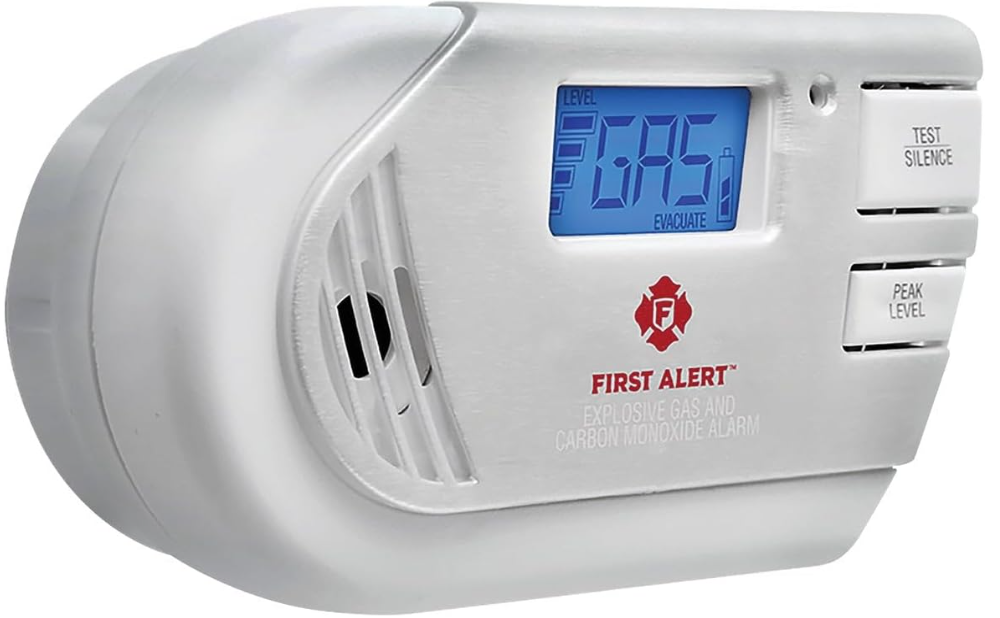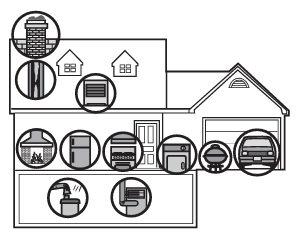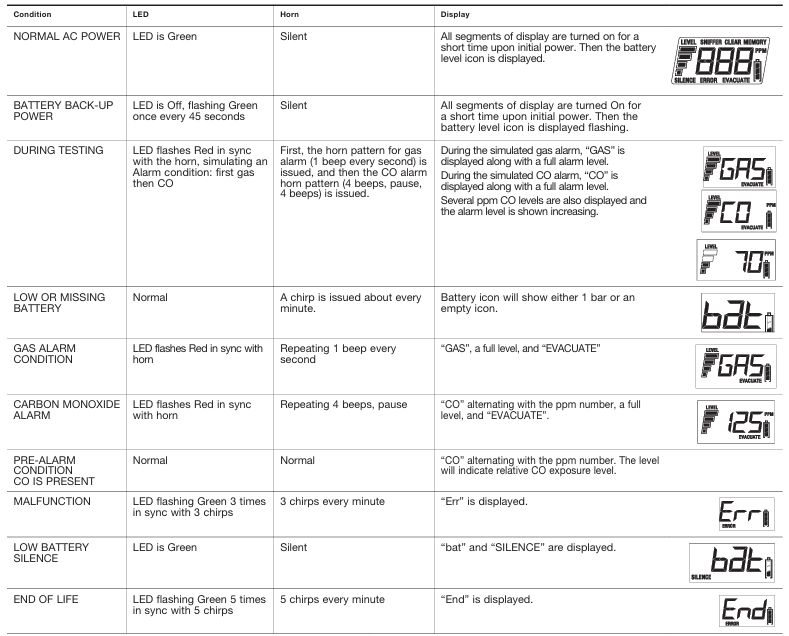First Alert GCO1 Carbon Monoxide Alarm

Safety Instructions
- This CO Alarm will only indicate the presence of carbon monoxide gas at the sensor.
- Carbon monoxide gas may be present in other areas.
- The Silence Feature is for your convenience only and will not correct a CO problem.
- Always check your home for a potential problem after any alarm.
- Failure to do so can result in injury or death.
- This CO Alarm should receive continuous 120VAC, 60 Hz, pure sine wave electrical power.
- Do not use in an extension cord or outlet controlled by a dimmer or switch.
- NEVER ignore your Carbon Monoxide Alarm if it alarms.
- Refer to “If Your CO Alarm Sounds” for more information.
- Failure to do so can result in injury or death.
- If the CO Alarm is not working properly, it cannot alert you to a problem.
- For additional information on carbon monoxide and your medical condition, contact your physician.
Co Alarm Works
- Leave your CO Alarm plugged in year-round.
- When fully powered, the unit samples the air and takes a new reading about every second.
- This CO Alarm features a permanently installed sensor, an indicator light, and an 85 dB alarm horn.
- It also has a Silence Feature to temporarily quiet the alarm horn.
Alarm Sevice
- The light flashes (RED) and the horn sounds 3 “chirps” every minute. The O Alarm needs to be replaced.
Reached End Of Life
- The light flashes (RED) and the horn sounds 5 “chirps” every minute. The CO Alarm needs to be replaced.
Understanding
Battery Power
- Light flashes every minute. Horn is silent.
Low Battery
- The light continues to flash (R, ED), and the horn also “chirps” once every minute.
- This warning should last for up to 7 days, but you should replace the battery as soon as possible.
Testing
- Light flashes Red in sync with the horn pattern (4 beeps, pause, 4 beeps), simulating a CO Alarm condition.
Installation
Where to Install
- The National Fire Protection Association (NFPA) recommends that a CO alarm be centrally located outside of each separate sleeping area near the bedrooms.
- For added protection, install additional CO Alarms in each separate bedroom and on every level of your home.
- If your bedroom hallway is longer than 40 feet (12 meters), install a CO Alarm at BOTH ends of the hallway.
Single-level Home
- Install at least one CO Alarm near or within each separate sleeping area.
- For added protection, install an additional CO Alarm at least 20 feet (6 meters) away from the furnace or fuel-burning heat source.
Multi-level Home
- Install at least one CO Alarm near or within each separate sleeping area.
- For added protection, install at least one CO Alarm on each level of the home.
- For added protection, install an additional CO Alarm at least 20 feet (6 meters) away from the furnace or fuel-burning heat source.
Mobile Homes
- Install CO Alarms on inside walls ONLY. Uninsulated outside walls and roofs of mobile homes often transfer heat and cold from outdoors.
- The Alarm should be located at least 6 inches (152 mm) from all exterior walls and at least 12 inches (305 mm) from supply or return vents.
How to Install
- In garages, kitchens, furnace rooms, or in any extremely dusty, dirty, or greasy areas.
- Closer than 20 feet (6 meters) from a furnace or other fuel-burning heat source, or fuel-burning appliances like a water heater.
- Within 5 feet (1.5 meters) of any cooking appliance. In extremely humid areas.
- These areas include unconditioned crawl spaces, unfinished attics, uninsulated or poorly insulated ceilings, porches, and garages.
- In turbulent air, like near ceiling fans, heat vents, air conditioners, fresh air returns, or open windows. Blowing air may prevent CO from reaching the sensors.
- Outside the Mobile Home. In direct sunlight.
Potential Sources

- Excessive spillage or reverse venting of fuel appliances caused by outdoor conditions such as.
- Wind direction and/or velocity, including high, gusty winds.
- Heavy air in the vent pipes (cold/humid air with extended periods between cycles).
- Negative pressure differential resulting from the use of exhaust fans.
- Several appliances are running at the same time, competing for limited fresh air.
- Vent pipe connections are vibrating loose from clothes dryers, furnaces, or water heaters.
- Obstructions in or unconventional vent pipe designs can amplify the above situations.
- Extended operation of unvented fuel-burning devices (range, oven, fireplace).
- Temperature inversions can trap exhaust close to the ground.
- Car idling in an open or closed attached garage, or near a home.
How it Works


Limited Warranty
This warranty is valid for the original retail purchaser from the date of initial retail purchase and is not transferable. Keep the original sales receipt. BRK dealers, service centers, or retail stores selling BRK products do not have the right to alter, modify, or in any way change the terms and conditions of this warranty. BRK shall not be liable for any incidental or consequential damages caused by the breach of any express or implied warranty.
FCC Statement
This equipment generates, uses, and can radiate radio frequency energy and, if not installed and operated according toed by the instructions, may cause harmful interference to radio communications. However, there is no guarantee that the interference will not occur in a particular installation.
- Reorient or relocate the receiving antenna.
- Increase the separation between the equipment and receiver.
- Consult the dealer or an experienced radio or TV technician for help.
Customer Sevice
- Website: https://www.firstalertstore.com/
- Phone Number: 1-800-323-9005
FAQs
Q: What is the purpose of the First Alert GCO1 Carbon Monoxide Alarm?
Ans: To help prevent CO poisoning, the GCO1 is made to identify hazardous amounts of carbon monoxide (CO) gas in your house and sound an audible warning.
Q: Where should I install the GCO1 alarm?
Ans: Install the alarm on each floor of your house and close to the sleeping quarters. Install it on the wall or ceiling, preferably five feet above the ground, or as directed by the user manual.
Q: How do I install the GCO1 alarm?
Ans: Use the adhesive or screws that come with the item to mount it. To make sure the device is functioning, turn it on, put in the batteries (if necessary), and then push the Test button.
Q: What type of power source does the GCO1 use?
Ans: A sealed lithium battery with a 10-year lifespan is commonly used in the GCO1, meaning that battery replacement is not necessary during its useful life.
Q: How do I test the alarm?
Ans: Holding down the Test/Silence button will cause the LED indicator to flash and a loud alarm to sound. This attests to the unit’s correct operation.
Q: What happens when the alarm detects carbon monoxide?
Ans: When dangerous CO levels are detected, the alarm displays red lights and makes a loud, pulsing beep. Professional assistance and an immediate evacuation are advised.
Q: Can I silence a false alarm?
Ans: Yes, you can temporarily turn off the alarm by pressing the Test/Silence button. Evacuate and contact emergency services if the alert persists or you suspect the presence of CO.
Q: How long does the GCO1 alarm last?
Ans: The lifespan of the GCO1 alarm is roughly ten years. When it needs to be replaced, it will notify you with a chirp.



